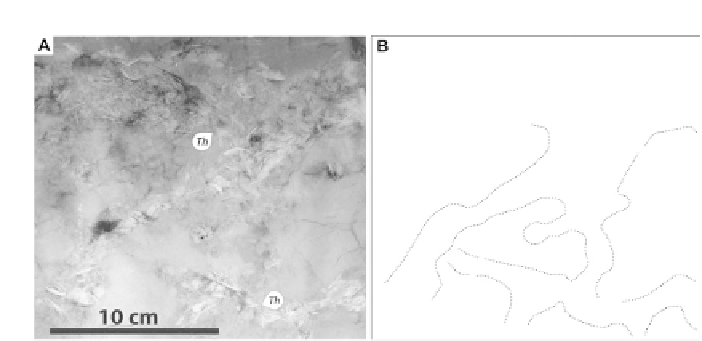Environmental Engineering Reference
In-Depth Information
FIGURE 8
(A) X-radiograph of a modern estuary-mouth deposit of Ogeechee River, Georgia,
USA. In this area, the tidal-inlet channel has cut down into palimpsest muddy sands, and a firm-
ground
Thalassinoides
-dominated suite attributable to the
Glossifungites
Ichnofacies is present.
Shell detritus infills the shrimp burrows. (B) Line tracing of the burrows.
is denoted by the presence of
Thalassinoides-
,
Skolithos-
,
Palaeophycus-
,and
Planolites-
like structures (e.g.,
Fig. 2
E), as well as cryptobioturbation.
The outer estuary of the Ogeechee system is dominated by polyhaline waters
and contains the highest diversity of infaunal species. The major bioturbating
elements of the community are capable of producing cryptic mottling, as well
as biogenic sedimentary structures including
Skolithos
,
Thalassinoides
(
Fig. 7
),
Palaeophycus
,
Planolites
,
Arenicolites
,
Diplocraterion
,
Gyrolithes
,
Polyklad-
ichnus
, and
Chondrites
. Despite the heightened diversity of the community,
the outer estuary shows reduced bioturbation intensities overall, which is
attributed to increased rates of sediment deposition and bedform migration.
The degree of bioturbation is lower in both the intertidal flats (BI
¼
2-3) and
subtidal environments (BI
¼
1-2).
3.6 Tide-Dominated Estuaries
A result of the presence of a very large tidal prism is that tide-dominated estu-
aries tend to be large and that their physiographic boundaries are greatly atten-
uated (
Dalrymple et al., 1992
). Facies changes are gradational over a scale of
several kilometers to tens of kilometers. Saltwater incursion can extend over
long distances inland—although this is greatly influenced by fluvial
discharge—and vigorous tidal currents can effectively disrupt the vertical strati-
fication of the water column within the estuary.
Most commonly, the inner estuary of tide-dominated estuaries is dominated
by salt marshes, muddy intertidal substrates, and variably muddy or sandy sub-
tidal sediments. Oligohaline or mesohaline waters are typically present. Muddy
intertidal flats are commonly bioturbated; however, high current energies
within the channels tend to limit the degree and diversity of bioturbation in
the subtidal inner estuary.






Search WWH ::

Custom Search